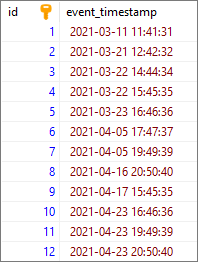EN
Node.js - PostgreSQL- group rows by months
0
points
In this article, we would like to show you how to group rows by months in the Postgres database from Node.js level.

Note: at the end of this article you can find database preparation SQL queries.
const pg = require('pg');
const types = pg.types;
types.setTypeParser(1114, (stringValue) => {
return stringValue;
});
const client = new pg.Client({
host: '127.0.0.1',
user: 'my_username',
database: 'my_database',
password: 'my_password',
port: 5432,
});
const fetchEventsGroupedByMonths = async () => {
const query = `
SELECT
DATE_TRUNC('month', "event_timestamp") AS "month",
COUNT(*)
FROM "events"
GROUP BY DATE_TRUNC('month', "event_timestamp")
`;
await client.connect(); // creates connection
try {
const { rows } = await client.query(query); // sends query
return rows;
} finally {
await client.end(); // closes connection
}
};
fetchEventsGroupedByMonths()
.then(result => console.table(result))
.catch(error => console.error(error.stack));
Result:
┌─────────┬───────────────────────┬───────┐
│ (index) │ month │ count │
├─────────┼───────────────────────┼───────┤
│ 0 │ '2021-03-01 00:00:00' │ '5' │
│ 1 │ '2021-04-01 00:00:00' │ '7' │
└─────────┴───────────────────────┴───────┘
Note:
In the example above, the
monthcolumn shows the date 1 day back (time zone-adjusted conversion), check the example below, which may be clearer for you.
Another solution
const { Client } = require('pg');
const client = new Client({
host: '127.0.0.1',
user: 'my_username',
database: 'my_database',
password: 'my_password',
port: 5432,
});
const fetchEventsGroupedByMonths = async () => {
const query = `
SELECT
TO_CHAR(event_timestamp,'month') AS "month",
EXTRACT(YEAR FROM event_timestamp) AS "year",
COUNT(*)
FROM "events"
GROUP BY TO_CHAR(event_timestamp,'month'), EXTRACT(YEAR FROM event_timestamp) // or GROUP BY 1,2
`;
await client.connect(); // creates connection
try {
const { rows } = await client.query(query); // sends query
return rows;
} finally {
await client.end(); // closes connection
}
};
fetchEventsGroupedByMonths()
.then(result => console.table(result))
.catch(error => console.error(error.stack));
Result:
┌─────────┬─────────────┬──────┬───────┐
│ (index) │ month │ year │ count │
├─────────┼─────────────┼──────┼───────┤
│ 0 │ 'march ' │ 2021 │ '5' │
│ 1 │ 'april ' │ 2021 │ '7' │
└─────────┴─────────────┴──────┴───────┘
Database preparation
create_tables.sql file:
CREATE TABLE "events" (
"id" SERIAL PRIMARY KEY,
"event_timestamp" TIMESTAMP NOT NULL
);
insert_data.sql file:
INSERT INTO "events"
("event_timestamp")
VALUES
('2021-03-11 11:41:31'),
('2021-03-21 12:42:32'),
('2021-03-22 14:44:34'),
('2021-03-22 15:45:35'),
('2021-03-23 16:46:36'),
('2021-04-05 17:47:37'),
('2021-04-05 19:49:39'),
('2021-04-16 20:50:40'),
('2021-04-17 15:45:35'),
('2021-04-23 16:46:36'),
('2021-04-23 19:49:39'),
('2021-04-23 20:50:40');
Native SQL query (used in the above example):
Example 1:
SELECT
DATE_TRUNC('month', "event_timestamp") AS "month",
COUNT(*)
FROM "events"
GROUP BY DATE_TRUNC('month', "event_timestamp")
Example 2:
SELECT
TO_CHAR(event_timestamp,'month') AS "month",
EXTRACT(YEAR FROM event_timestamp) AS "year",
COUNT(*)
FROM "events"
GROUP BY TO_CHAR(event_timestamp,'month'), EXTRACT(YEAR FROM event_timestamp) // or GROUP BY 1,2